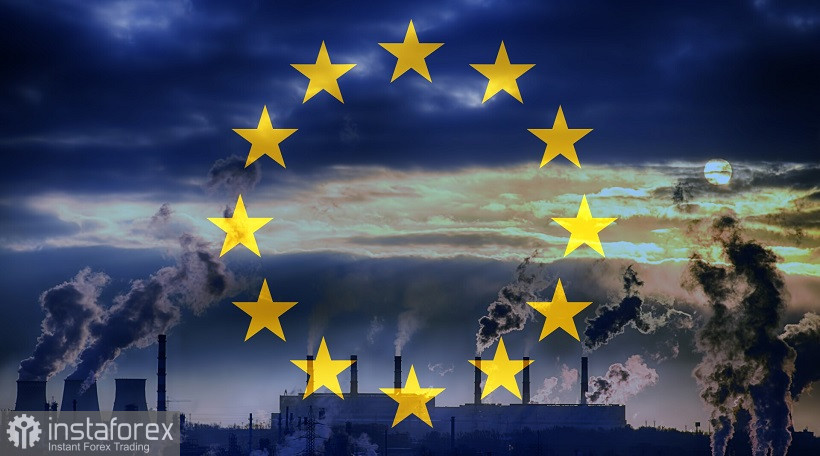The euro-dollar pair did not keep the high. EUR/USD bulls have once again tested the resistance level of 1.1150 today, but could not settle above this target. As soon as traders overcame this price barrier, they met active resistance from bears. As a result, the pair retreated, falling by more than a hundred points.

Let's start with an important macroeconomic report that was published at the start of the US session. We learned the dynamics of the most preferred inflation indicator by the Federal Reserve – the Personal Consumption Expenditure Index (PCE). For several months now, it has significantly exceeded the Fed's target level. It is believed that this indicator is monitored by members of the Fed "with special attention".
The core PCE index, which does not take into account volatile food and energy prices, jumped in February to 5.4% (in annual terms). This is the strongest growth rate since June 1983 (!). At the same time, the January result was revised upwards (from 5.1% to 5.2%). The indicator has been consistently and steadily growing for six months. For comparison, it can be noted that at the beginning of last year, the RCE fluctuated in the range of 1.4%-1.9%, but then it gradually began to gain momentum, and especially actively over the past six months. Today's release was a logical addition to another inflation report, which reflected a record increase in the consumer price index. Let me remind you that the overall CPI accelerated to 7.5% y/y – this is the highest value of the indicator over the past 40 years. The last time this indicator was at this level was in March 1982. The core consumer price index, excluding volatile food and energy prices, similarly shot up. In monthly terms, an increase of up to 0.6% was recorded, in annual terms – up to 6.0% (with a growth forecast of up to 5.9%). And here again is a long-term record: the index last "gave out" such results in annual terms in 1982.
In other words, inflation indicators continue to please dollar bulls with record growth rates. The market reaction was not long in coming: paired with the euro, the dollar strengthened by more than a hundred points today. The pair pushed off from a four-week price high of 1.1187 and "landed" around the 1.1050 mark (at this price point, the Tenkan-sen and Kijun-sen lines connect on the daily chart). This is where the "bear holiday" is over for now: the downward momentum has faded.
Nevertheless, today's price dynamics suggests that long positions for the pair still look extremely risky. The divergence of the positions of the Fed and the European Central Bank has not gone away, while the geopolitical fundamental factors (to which the US currency reacts so sensitively) are a priori unreliable. The general mood of the market changes several times a day, depending on which way the "information wind" is directed. The focus is on the negotiation process between Russia and Ukraine, which will resume tomorrow, April 1. Given the fact that the parties are still far from concluding a final agreement, the craving for risk in the market has gradually decreased. The dollar, accordingly, began to gradually gain momentum, against the background of general nervousness and geopolitical instability.
The euro, in turn, came under pressure from the so-called "gas issue". So, the president of Russia announced today that he signed a decree on the transfer of payments for gas with unfriendly countries in rubles. According to the decree, buyers of Russian gas will need to open ruble accounts in Russian banks to pay for supplies from April 1. It should be recalled here that the list of countries unfriendly to Russia includes, in particular, the countries of the European Union. And the head of the French Finance Ministry has already stated, "France and Germany will not pay for gas in rubles." Earlier, similar statements were made by representatives of some other EU countries.
Against the background of the threat of gas outages for European consumers, the price of "blue fuel" in Europe today has soared to almost $1,500 per thousand cubic meters. But the euro sank throughout the market – not only paired with the dollar, but also in the main cross-pairs.
Thus, the EUR/USD pair was under quite strong pressure today. The dollar received support from the inflationary release and geopolitical factors, while the single currency fell under the ice rink of the "gas problem".
Most likely, in the short term, the pair will trade in the 100-point price range of 1.1050-1.1150 (the Tenkan-sen and Kijun-sen lines connect at the lower price point, the upper point corresponds to the upper line of the Bollinger Bands indicator on the daily chart). In my opinion, at the moment the priority is short positions, which are convenient to open on the upward pullbacks. The pair can demonstrate significant growth only on a breakthrough in negotiations, while all other fundamental factors are now playing against the euro and/or in favor of the dollar.





















